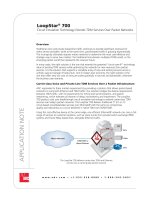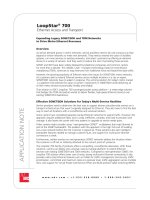LoopStar® 700 Ethernet and TDM Services Over Fiber to Multiple Customers and Locations
Bạn đang xem bản rút gọn của tài liệu. Xem và tải ngay bản đầy đủ của tài liệu tại đây (422 KB, 4 trang )
ApplicAtion note
LoopStar
®
700
Ethernet and TDM Services Over Fiber to Multiple Customers and Locations
w w w . a d c . c o m • + 1 - 9 5 2 - 9 3 8 - 8 0 8 0 • 1 - 8 0 0 - 3 6 6 - 3 8 9 1
Overview
Metro area telecommunications providers need to deliver a mix of inherently incompatible services
to enterprise customers, who expect compatibility and consistency across all their locations.
Under pressure to provide bundled services at lowest possible costs, with fast response to service
requests, service providers need to reach all of their customer locations in the most cost-effective
way. They need to evaluate the cost of running separate circuits to each location to support
disparate services, and have to consider the bottom-line justification for extending services into
areas where only one prospect may be lined up. Service providers also need to determine whether
equipment costs can be justified if that first sale doesn’t lead to more business from that location.
Historically, service providers have had three sub-optimal responses to these challenges:
• Run redundant network links (owned or leased circuits) to customer locations to provide the mix
of packet and TDM (time division multiplex) services they require.
• Use “dumb” gateway devices to aggregate services for transport, but sacrifice the ability
to monitor performance all the way to the network edge and deliver on service level
agreements (SLAs).
• Deploy high-powered SONET add-drop multiplexers (ADMs) or Layer 2 packet switches to
build out the metro network, but only for service areas that cost-justify the expenditure.
The first option is cumbersome and costly. The second approach is inexpensive, but inadäquate
to meet customer expectations for network performance. The third strategy is suitable for high-
density serving areas, but doesn’t address new markets or small branch locations of the best
enterprise customers.
Other options include traditional time division multiplex (TDM) services, such as voice trunks
from private branch exchange (PBX) systems and leased-line data services, which still represent
substantial revenue. Providers need to determine the best way to win business from customers
who want Ethernet and TDM services from a single provider.
Challenges include serving a high-rise building or campus and reaching customers beyond the 100-
meter limit of Ethernet connections, or when the provider is restricted to fiber risers. What if there
is an opportunity to extend service to a nearby customer, but the revenue potential doesn’t cost-
justify extending the metro SONET/SDH or packet ring to that location?
4 / 0 6 • 1 0 2 1 1 7 A E
LoopStar
®
700
Ethernet and TDM Services
LoopStar
®
700
2
w w w . a d c . c o m • + 1 - 9 5 2 - 9 3 8 - 8 0 8 0 • 1 - 8 0 0 - 3 6 6 - 3 8 9 1
The LoopStar 700 product suite is ideally suited for all of these situations. This multi-service access
solution delivers flexible, business-class TDM and Ethernet-based services over packet backbones. With
a cost-effective LoopStar 700 at the main point of presence (PoP), one standard network can carry a full
range of traditional services, such as PBX tie lines, Frame Relay private lines and video teleconferencing
alongside Ethernet LAN traffic.
This carrier-class edge platform uses a compact, flexible architecture, enabling service providers to deliver
a full array of services at lower costs, while positioning the network for an intelligent evolution to next-
generation networks. Multi-service traffic can be transported efficiently across a single network, rather
than using expensive overlay schemes.
One or more LoopStar 700s can subtend off another LoopStar 700 through a fiber or copper riser
to extend multi-service capabilities to all floors in a high-rise building or all buildings in a campus or
business park. This subtending configuration, coupled with a modular interface architecture, makes
it economical to extend services to small serving areas – and gain early-mover advantage to promote
additional services. Hub-and-spoke, ring extension, and combinations of those topologies are supported.
Customer A
TDM
Ethernet
PBX
Switch/Router
Customer B
Customer C
Metro Network
(over SONET/SDH
or Optical Ethernet)
Switch/Router
TDM
Ethernet
PBX
Switch/Router
TDM
Ethernet
PBX
LS
700
LS
700
LS
700
Extend Carrier-Class TDM and Ethernet Services Throughout Multi-tenant Locations
The LoopStar 700 system is optimized for metropolitan area networks serving single enterprise
customers, multi-tenant units, and campus environments. This versatile platform is ideally suited for
several key applications:
• Leverage metro SONET/SDH networks to carry Ethernet services, aggregating packet and TDM traffic
onto a single uplink into an ADM.
• Drive metro packet networks to carry traditional TDM services, using a robust and patented circuit
emulation technique that converts TDM traffic into packets for transport, and compensates for the
disparities between TDM and packet networks.
• Extend the reach of Ethernet and TDM services to all floors of a high-rise building or to all buildings
in a campus or business park environment through fiber-attached sub-networks.
In this third scenario, a LoopStar 700 can be attached to an existing ADM or Ethernet node within a
building’s PoP. Multiple LoopStar 700s can then be subtended off this LoopStar 700 via direct fiber.
Whether the metro network is based on SONET/SDH, NextGen SONET, Resilient Packet Ring (RPR) or
Optical Ethernet technologies, the LoopStar 700 product family offers a compelling choice for expanding
the reach of services.
A cost-effective LoopStar 700 system deployed today has a payback period of only 12 months or less
– even if only one customer is signed up. Once deployed, this versatile edge device offers a compelling
solution for bundled services to customers of all sizes.
4 / 0 6 • 1 0 2 1 1 7 A E
LoopStar
®
700
Ethernet and TDM Services
LoopStar
®
700
3
w w w . a d c . c o m • + 1 - 9 5 2 - 9 3 8 - 8 0 8 0 • 1 - 8 0 0 - 3 6 6 - 3 8 9 1
Features and Benefits
The LoopStar 700 product family was designed
from the ground-up to support multiple services
at the carrier edge and customer premises,
offering several important advantages for this
service-extension solution:
Lower cost of entry. With the LoopStar 700
solution, carriers can extend high-demand
Ethernet and TDM services to new locations
without the high costs associated with building
out the metro network. Whether using multiple
T1/E1s bonded together or point-to-point fiber
runs, cost justifications can be made on an
individual case basis to effectively light a new
building. Since this solution carries a lower cost
than extending the metro ring, it is much easier
for a carrier to cost-justify – both as an early
entry solution into a new market as well as a
permanent, cost-effective alternative to extending
the entire fiber ring.
Simplified network architectures. The LoopStar
700 dramatically reduces the cost and complexity
of extending services throughout multi-tenant
units and campus environments. For example,
instead of terminating separate access circuits for
each tenant, TDM and Ethernet services can be
consolidated onto a single link. Since all traffic is
packetized, there is no need to aggregate circuit
and packet traffic separately in the transport
network or back in the central office.
Support for multiple customers with a single
platform. There’s no need to deploy a separate
LoopStar 700 platform for each customer in a
multi-tenant building or campus environment.
Virtual LAN (VLAN) tagging of traffic entering
the LoopStar 700 unit, based on IEEE 802.1Q
standards, segregates traffic from multiple
customers for security, traffic management,
and differenti¬ated treatment at seven different
priority levels. Rate limiting at 1Mbps increments,
on a per-port or per-VLAN basis, allows
the carrier to carefully define how bandwidth is
allocated on that shared platform.
In the campus or high-rise POP, a single LoopStar
700 platform can aggregate traffic from multiple
subtending LoopStar 700 units. Other solutions
require a hub counterpart for every edge device in
the field.
New service opportunity from existing networks
Where the backbone is a SONET/ SDH network,
the LoopStar 700 can transport Ethernet services
over that infrastructure. Where the backbone is
a packet network, and existing Layer 2 switches
already bring Ethernet LAN traffic onto the
network, a LoopStar 700 can add TDM traffic
to the mix without requiring an expensive and
cumbersome overlay network. In either case,
the result is increased revenues, better customer
retention and expanded service opportunities.
Flexible interfaces. The LoopStar 750 and
LoopStar 720 can provide uplinks of NxT1/E1,
DS3, OC-3c/STM1, OC-12c/STM4, 100Base-FX
Ethernet and Gigabit Ethernet. On the subscriber
side, copper and fiber Ethernet interfaces are
supported, as well as T1/E1s.
Any combination of Ethernet and TDM bandwidth
can be supported, up to the payload rate of the
uplink. For example, a DS3 can be provisioned
to carry a few T1s for PBX or videoconferencing
traffic, and the rest of the bandwidth can be
used for Ethernet services, allocated in 1 Mbps
increments. When more bandwidth is required,
the con¬nection can be increased as needed
without physically changing the interface.
Streamlined management and provisioning.
Because a single, universal platform supports
packet and TDM services – both in the PoP and
throughout in-building and campus networks
– carriers no longer have to manage multiple
customer-premise devices from different vendors.
LoopStar 700 products support a single point of
provisioning and management, eliminating the
need to make expensive changes on many metro
devices within the network.
Visibility to the customer premises. The
LoopStar 700 platform provides management
visibility out to the customer-premise equipment
without requiring a separate (out-of-band) overlay
management network. Because all equipment
is owned by the carrier, multiple points of
demarcation can be established and dynamically
tailored as real time situations require, greatly
simplifying fault isolation and troubleshooting of
network conditions.
Web Site: www.adc.com
From North America, Call Toll Free: 1-800-366-3891 • Outside of North America: +1-952-938-8080
Fax: +1-952-917-3237 • For a listing of ADC’s global sales office locations, please refer to our web site.
ADC Telecommunications, Inc., P.O. Box 1101, Minneapolis, Minnesota USA 55440-1101
Specifications published here are current as of the date of publication of this document. Because we are continuously
improving our products, ADC reserves the right to change specifications without prior notice. At any time, you may
verify product specifications by contacting our headquarters office in Minneapolis. ADC Telecommunications, Inc.
views its patent portfolio as an important corporate asset and vigorously enforces its patents. Products orfeatures
contained herein may be covered by one or more U.S. or foreign patents. An Equal Opportunity Employer
102315AE 4/06 Original © 2006 ADC Telecommunications, Inc. All Rights Reserved
ApplicAtion note
LoopStar
®
700
Extending the reach of revenue services.
In a competitive arena, service providers cannot afford to build out the metro network unless return on
investment is assured. Yet this cautious approach could cost the carrier over the longer term in missed
opportunities.
The LoopStar 700 solution makes the business case for multi-tenant markets more compelling than
ever. This cost effective platform reaps revenue from TDM services while optimizing the network for
burgeoning packet services. One universal solution supports on-demand access to a complete array of
services – new and existing – across a unified, easy-to-manage infrastructure.
Providers can start with a low-cost entry, than scale easily in services and bandwidth whenever the
business case warrants. These benefits can be extended throughout in-building or campus networks
– fiber or copper risers – without costly build-out of the metro network.
Why the LoopStar 700?
The LoopStar 700 platform features a compact, flexible architecture that enables service providers to
deliver a full array of services at lower costs, while positioning the network for an intelligent evolution to
next-generation networks.
This versatile platform is excellent for several key applications, including leveraging metro SONET/SDH
networks to carry Ethernet services, providing metro packet networks to carry traditional ADM services,
and extending the reach of Ethernet and TDM services through fiber-attached sub-networks.









